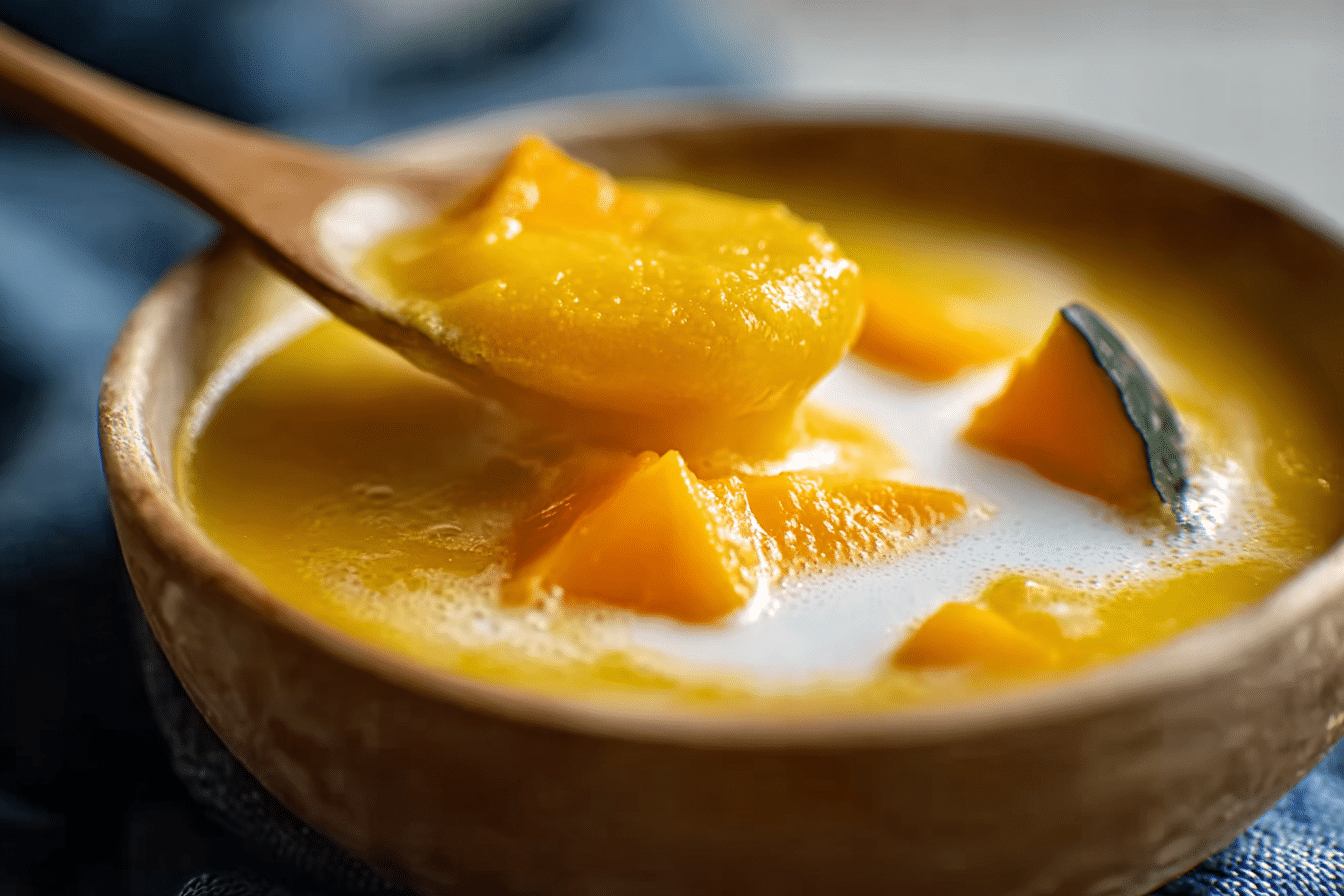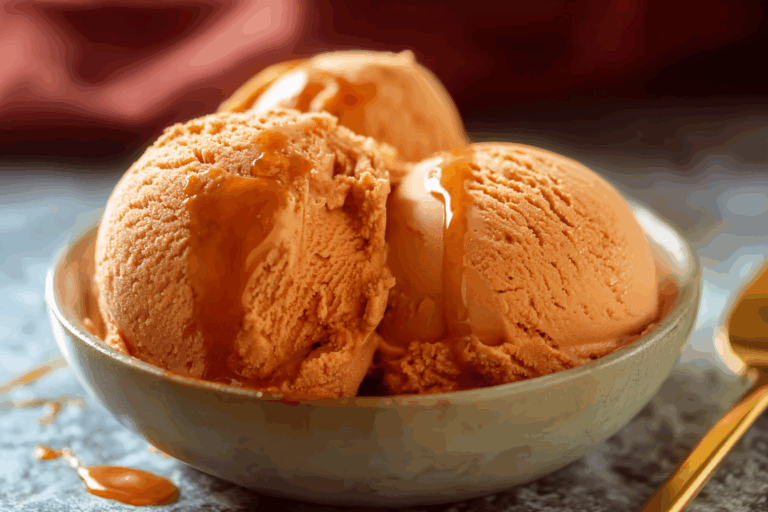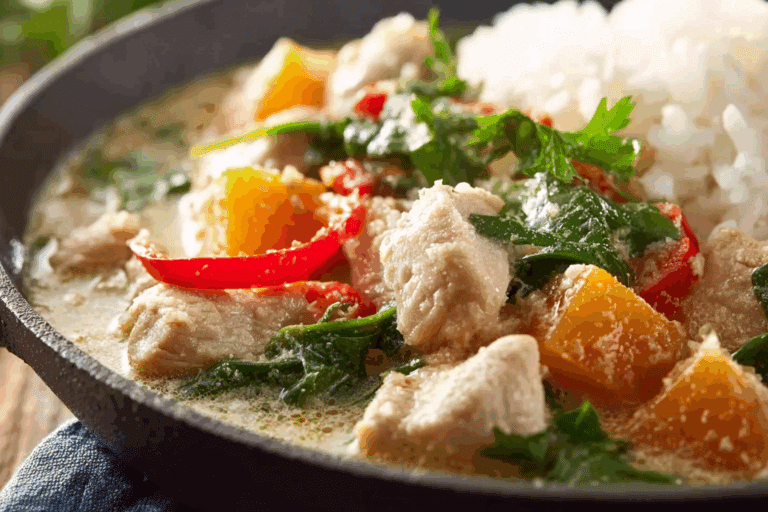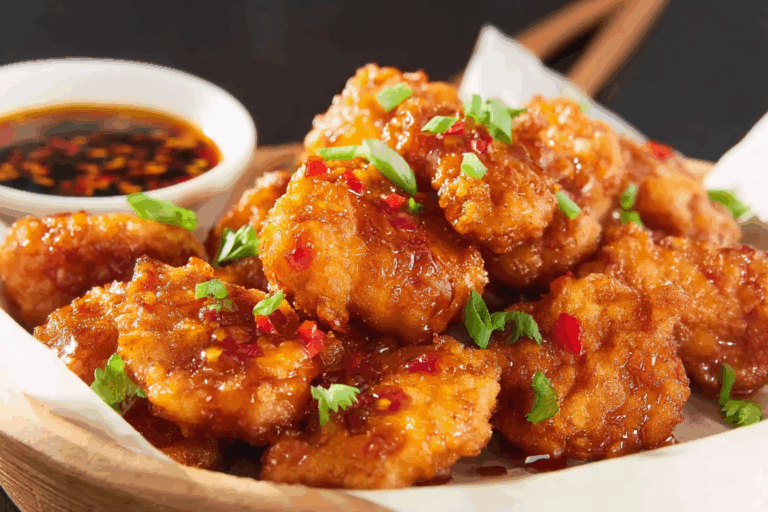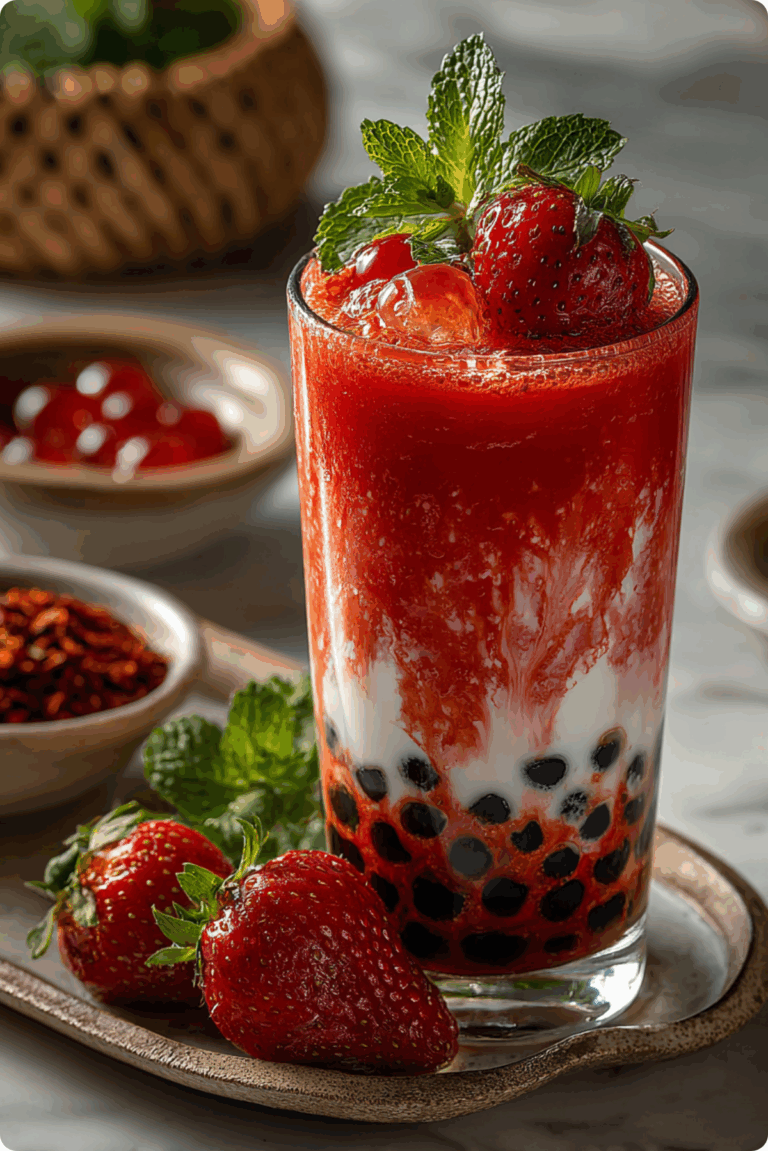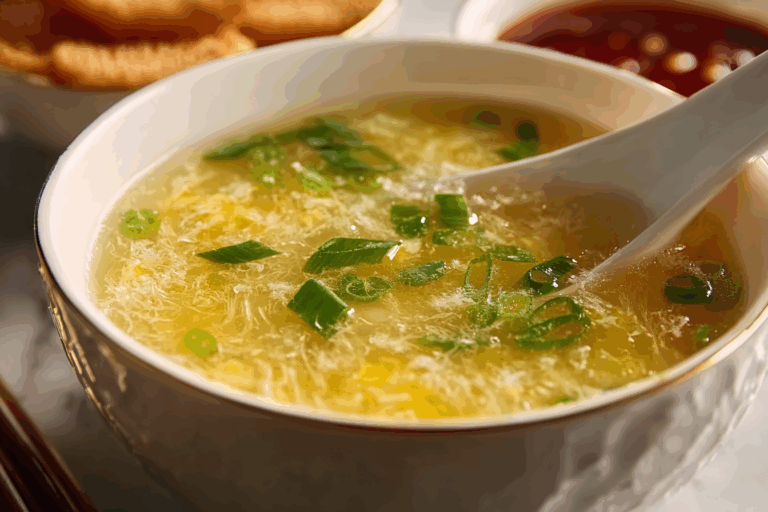Pumpkin in Coconut Milk Dessert: Traditional Thai Sweet Recipe
Pumpkin in Coconut Milk is not just a dessert; it’s an experience of flavors that beautifully captures the essence of Thai cuisine. This traditional dish, also known as “Fak Thong Kaeng Buat” in Thailand, combines the creaminess of coconut milk with the natural sweetness of pumpkin to create a comforting treat that’s perfect for any occasion.
Our journey at Just Thai Recipes started with a simple passion: to share the bold, beautiful flavors of Thailand with food lovers around the world. As shared on our About page, Lina, the founder, began this culinary adventure to bring the vibrant street foods and home-style recipes of Thailand to every kitchen. The love for authentic recipes like pumpkin in coconut milk fuels this mission every day.
In this article, you’ll discover the history, preparation, variations, and health benefits of this amazing dessert. You’ll also learn tips to perfect it, avoid common mistakes, and find answers to the most asked questions about this dish. Throughout, we’ll explore different ways to enjoy pumpkin in coconut milk, from classic recipes to savory curries and even creative fusion dishes.
Looking for inspiration? Try our collection of Thai desserts to expand your dessert repertoire.
Table of Contents
Table of Contents
What is Pumpkin in Coconut Milk?
Origins of Pumpkin in Coconut Milk
Pumpkin in coconut milk has deep roots in Thai culinary tradition. Historically, this dish was served during family gatherings and festive occasions. Thai households cherish it for its simplicity and the ease with which it can be adapted. The dish belongs to a category of Thai desserts called “kaeng buat,” where various fruits or vegetables are cooked in sweetened coconut milk. The word “buat” itself refers to the process of simmering in coconut milk, a common cooking technique in Thai sweets.
Interestingly, while it is a traditional dessert, variations have spread across Southeast Asia and beyond. In neighboring countries like Cambodia and Laos, similar recipes exist, each with slight modifications in sweetness and texture. Over time, pumpkin in coconut milk has also been embraced by Western kitchens, often tweaked with spices or garnishes to suit local palates.
Why This Dessert is Loved Worldwide
The global love for this dish lies in its harmony of flavors and textures. The sweetness of pumpkin melds perfectly with the rich creaminess of coconut milk, creating a dessert that’s both satisfying and nourishing. Coconut milk adds a layer of tropical richness, while palm sugar gives it a delicate caramel undertone.
Beyond its taste, it’s a versatile recipe. You can serve it warm for a cozy treat during cold weather or chilled for a refreshing dessert in summer. Plus, it’s naturally gluten-free and can be made vegan-friendly, which appeals to a wide range of dessert lovers worldwide.
The growing popularity of plant-based diets has also contributed to its rise. Many food enthusiasts are discovering pumpkin in coconut milk as a healthy alternative to heavy dairy desserts. Check out this easy Thai fish curry if you want to explore more dishes where coconut milk shines as a star ingredient.
This dessert also pairs well with other Thai meals, providing a sweet finish to spicy main courses. Its balance of sweetness and creaminess makes it an all-time favorite not just in Thailand but also among international foodies who crave comfort in a bowl.
Ingredients You Need for Pumpkin in Coconut Milk
Essential Ingredients
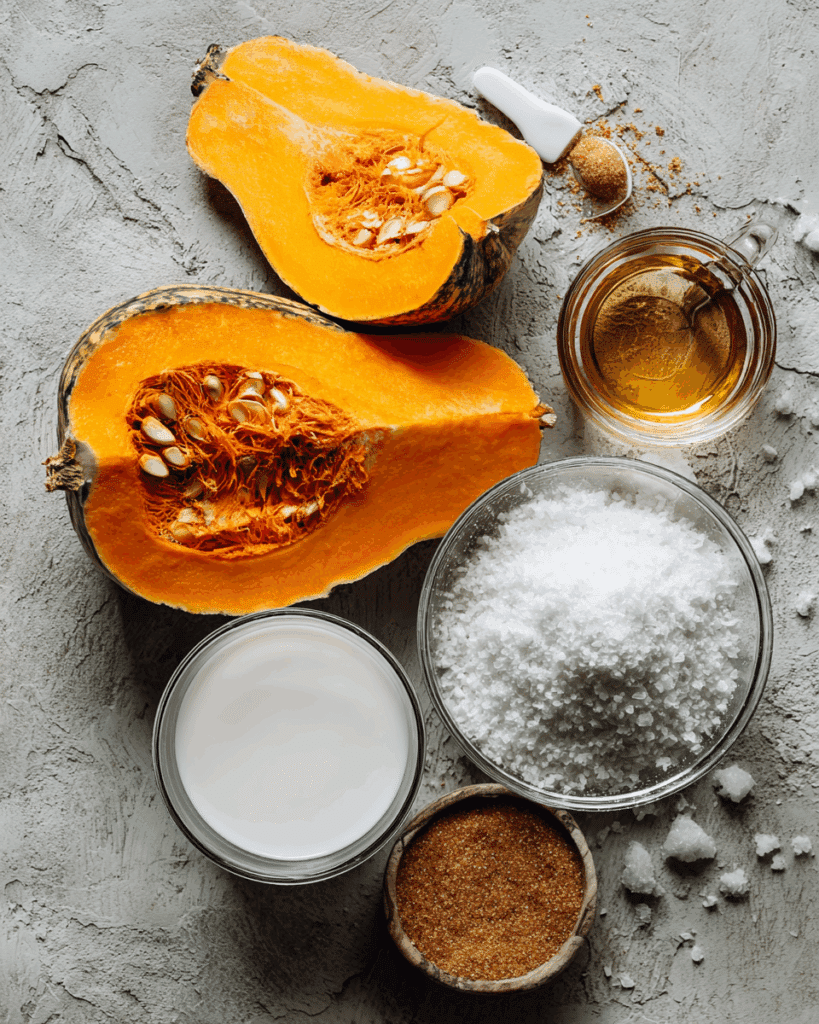
To make an authentic Thai pumpkin in coconut milk dessert, you need just a few simple ingredients. Each plays an important role in creating the rich, creamy texture and balanced sweetness this dish is famous for:
- 1 cup coconut milk – The heart of this recipe. Opt for a high-quality, full-fat coconut milk for the best flavor and creaminess. Avoid light versions, as they may lack the richness needed.
- 1 cup water – Helps balance the thickness of the coconut milk so it doesn’t overpower the pumpkin.
- ¼ cup palm sugar – This traditional Thai sweetener gives the dish a deep, caramel-like sweetness. If you can’t find palm sugar, brown sugar is a good substitute.
- 2 cups kabocha squash (pumpkin) – Kabocha, known for its natural sweetness and creamy flesh, is ideal. However, you can also use butternut or sugar pumpkin if kabocha isn’t available.
- ¼ teaspoon salt – A pinch of salt enhances all the flavors and keeps the dessert from being overly sweet.
Optional Ingredients to Enhance Flavor
While the basic recipe is simple, adding a few optional ingredients can take it to another level:
- Pandan leaves – Add them to the pot while simmering for a fragrant, vanilla-like aroma typical of Thai desserts.
- Roasted sesame seeds – Sprinkle on top before serving for a nutty contrast.
- Extra coconut cream – Drizzle over the finished dessert to add richness and make it visually appealing.
- Cinnamon or nutmeg – For a fusion twist, a dash of these spices brings warmth, especially if you enjoy pumpkin spice flavors.
If you enjoy creamy dishes, you might also like to explore Coconut Mango Chicken Curry, where coconut milk plays a similarly rich role.
Ingredient Tips
Always use fresh pumpkin rather than canned for authentic texture. When shopping, choose a pumpkin that feels heavy for its size with a firm, deep-colored skin. If you are experimenting with other variations, like pumpkin in coconut cream curry or pumpkin in coconut cream Indian style, slightly adjust the amount of coconut milk and spices to match your preference.
To learn more about using Thai ingredients in desserts, don’t miss our article on Thai Milk Tea Crème Caramel, which combines local flavors with creamy textures in another creative way.
Step-by-Step Recipe for Pumpkin in Coconut Milk
Preparing the Pumpkin
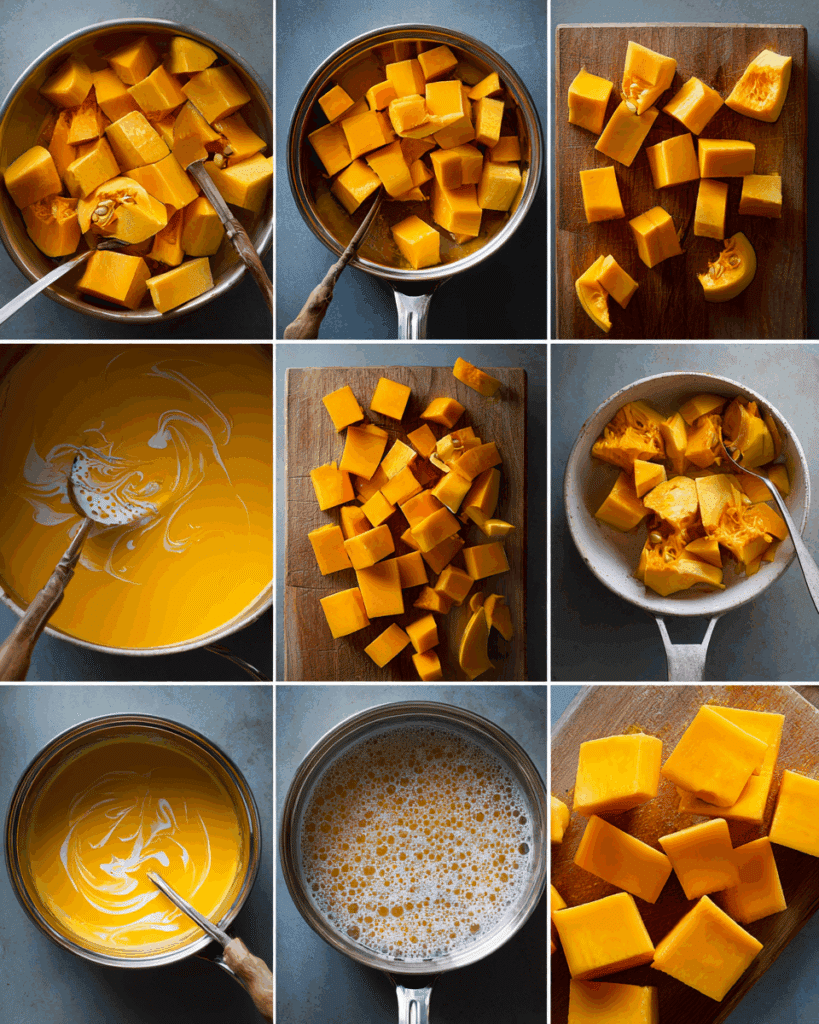
Start by washing your kabocha squash thoroughly. This variety is often coated in a thin film to preserve freshness, so make sure to scrub it well. Once clean, cut it in half, scoop out the seeds, and slice it into bite-sized cubes. You can choose to leave the skin on, which softens nicely when cooked, or remove it if you prefer a smoother texture. The skin adds extra nutrients and a slightly chewy bite that many people enjoy.
If you’re new to handling kabocha squash, you might find it quite firm. Use a sharp knife, and for safety, cut off a small portion of the bottom to create a flat base while cutting.
Cooking Process
The magic of this dessert lies in its simplicity. Here’s how to prepare it:
- Pour 1 cup of coconut milk and 1 cup of water into a medium-sized saucepan. Place the pot over medium-high heat.
- Add ¼ cup palm sugar and ¼ teaspoon salt to the liquid. Stir continuously until the sugar fully dissolves. This creates a sweet-salty base that complements the pumpkin perfectly.
- Add the pumpkin pieces into the pot. Make sure they are submerged in the sweetened coconut mixture.
- Reduce the heat to medium-low and let it simmer gently. Stir occasionally to prevent the coconut milk from sticking to the bottom or curdling.
- Simmer for about 10–15 minutes, or until the pumpkin is fork-tender but not falling apart. The pieces should hold their shape yet melt in your mouth.
- Skim off any froth that rises to the surface for a clean, silky finish.
- Serve the dessert warm in small bowls. For extra creaminess, swirl an additional spoonful of coconut cream on top before serving.
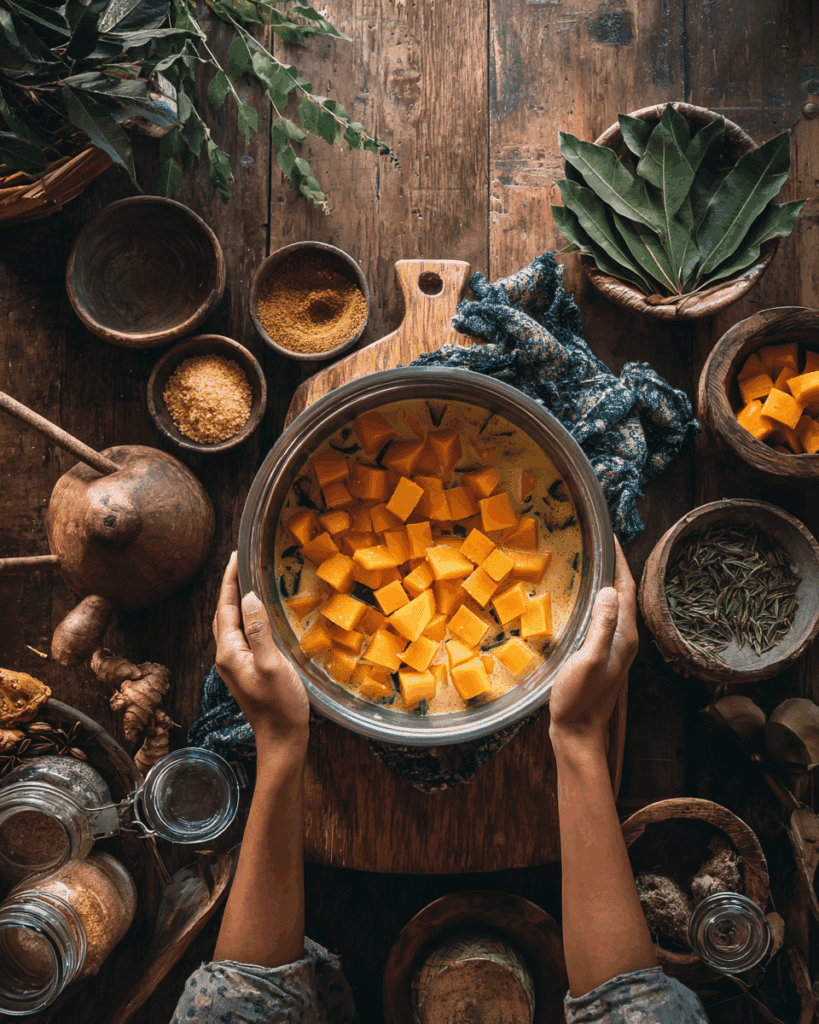
For those who love trying different variations, you can get more inspiration by reading the authentic Thai dessert recipe from Rachel Cooks Thai. It’s an excellent guide with step-by-step visuals.
Pro Tips for Best Results
- Simmer slowly. High heat can cause the coconut milk to split, so keep the temperature moderate.
- Taste as you go. Depending on your pumpkin’s sweetness, you may need to adjust the amount of palm sugar.
- Make it richer by substituting half of the coconut milk with coconut cream.
- For a chilled version, allow the dessert to cool and refrigerate it before serving. This method makes it refreshing during warmer months.
This recipe is so versatile that you can even convert it into a savory dish by adding spices and herbs. If you’re curious, check out how others have turned pumpkin and coconut into soups and curries like Thai Coconut Pumpkin Soup or a warming Pumpkin Coconut Curry for a dinner twist.
The balance of flavors in this dessert also matches the creamy texture highlighted in Serious Eats’ pumpkin in sweet coconut cream recipe, which offers another perspective on cooking this dish. Additionally, for those who prefer a soup-like version, try adapting this recipe using tips from Allrecipes’ pumpkin soup with coconut milk for a lighter, more liquid consistency.
Variations of Pumpkin in Coconut Milk Recipes
Pumpkin in Coconut Cream Recipe
A luxurious twist on the traditional dessert is to use coconut cream instead of coconut milk. Coconut cream is thicker and richer, giving the dish a more decadent texture. To make this version, replace half or all of the coconut milk in the recipe with coconut cream. The pumpkin absorbs the cream’s fat, resulting in a dessert that feels velvety and indulgent. This variation is often served at special events or when you want to impress guests with a more intense coconut flavor. Some cooks also drizzle extra coconut cream over the finished dessert as a final touch, which enhances its presentation and flavor.
When preparing pumpkin in coconut cream, it’s essential to simmer gently, as the higher fat content makes it more prone to curdling. Stir occasionally and use fresh ingredients for the best results. Adding a touch of pandan leaf while simmering can make the aroma irresistible.
Pumpkin in Coconut Cream Indian Style
If you enjoy the warmth of Indian spices, try making pumpkin in coconut cream Indian style. This variation combines the sweetness of pumpkin with the richness of coconut cream and adds spices like cardamom, cinnamon, and cloves. These spices infuse the dessert with a fragrant, slightly spicy profile that pairs beautifully with the creamy texture. To make it, simply follow the basic recipe but add a pinch of ground cardamom and a small cinnamon stick while simmering. Remove the cinnamon stick before serving.
This version is particularly popular among those who like their desserts aromatic with complex layers of flavor. The spices not only enhance the taste but also provide additional health benefits, such as improved digestion and warmth during colder months.
Pumpkin in Coconut Cream Curry
For a savory alternative, pumpkin in coconut cream curry transforms the concept of the dessert into a hearty meal. Instead of sweetening the coconut cream, season it with curry paste, garlic, and herbs. The pumpkin’s natural sweetness balances the spices, resulting in a delicious blend of flavors. The curry version often includes other vegetables, chickpeas, or even tofu for added texture and nutrition.
This dish is perfect for those who love Thai curries but want a lighter option. The pumpkin melts slightly into the sauce, giving the curry a creamy body without needing additional thickeners. For a complete meal, serve it with jasmine rice or roti.
Pumpkin and Coconut Milk Dessert with Modern Twists
Modern chefs have been experimenting with the traditional recipe to create exciting new desserts. Some use roasted pumpkin instead of simmered, which adds a slightly caramelized flavor. Others incorporate toppings like toasted coconut flakes, chia seeds, or even a scoop of vanilla ice cream for contrast. You can also blend the cooked pumpkin and coconut mixture to create a smooth pudding-like dessert, perfect for serving in individual cups.
These variations show how versatile pumpkin in coconut cream and pumpkin in coconut milk recipes can be. Whether you prefer a traditional Thai sweet, an Indian-spiced delight, or a savory curry, there’s a version to suit every taste.
Using Pumpkin in Savory Dishes
Pumpkin in Coconut Cream Curry

Pumpkin in coconut cream curry is one of the most comforting savory dishes you can prepare. Unlike the sweet Thai dessert, this version focuses on savory spices that balance perfectly with the natural sweetness of pumpkin. The base is made with thick coconut cream, which creates a luxurious sauce that clings to each piece of pumpkin. Traditional Thai curry pastes, such as red or yellow curry, are often used to give depth and warmth to the dish. When simmered, the pumpkin softens and absorbs the spicy coconut flavors, creating a harmonious blend that’s both creamy and flavorful. This curry pairs beautifully with jasmine rice, which helps soak up the delicious sauce.
To make pumpkin in coconut cream curry, begin by sautéing curry paste in a little oil to release its aroma. Add coconut cream slowly, letting it blend with the spices, then add pumpkin cubes and let them cook until tender. You can also include vegetables like green beans or spinach to add more texture. If you prefer a protein boost, tofu, chicken, or shrimp work well with the creamy base. The result is a vibrant dish with a rich coconut aroma and a mild sweetness that balances the spices perfectly.
Pumpkin Soup with Coconut Cream
Another savory option is pumpkin soup with coconut cream. This dish takes advantage of the pumpkin’s natural creaminess while enhancing it with the richness of coconut cream. The soup is silky smooth when blended and is often seasoned with a mix of ginger, garlic, and mild spices. Coconut cream adds a velvety texture and gives the soup a tropical touch that regular cream cannot match.
To prepare it, roast or boil the pumpkin until soft, then blend it with sautéed onions and garlic. Return the mixture to a pot, stir in coconut cream, and season with salt, pepper, and a hint of nutmeg for extra warmth. The soup can be served with a drizzle of extra coconut cream and fresh herbs on top, making it not only delicious but visually appealing. This variation is perfect for cooler weather when you need something warm and comforting.
Pumpkin in Coconut Cream with Spices
For those who love bold flavors, adding spices like turmeric, cumin, and coriander to pumpkin in coconut cream transforms it into a dish that’s both fragrant and hearty. These spices add depth and a golden hue to the dish, making it as beautiful as it is tasty. Unlike the dessert version, this savory recipe is balanced with salty and spicy elements that make it satisfying as a main course.
Pumpkin in coconut cream with spices is also excellent for meal prep, as the flavors develop even more after sitting overnight. Serve it with rice, naan bread, or even as a topping for noodles to enjoy its creamy and flavorful sauce in different ways.
Why Use Coconut Cream in Savory Pumpkin Dishes?
Coconut cream enhances savory dishes by adding richness without the heaviness of dairy cream. Its natural fats create a silky texture, and its mild sweetness complements pumpkin perfectly. When combined, they form a base that works equally well in curries, soups, and even baked casseroles. Coconut cream also pairs beautifully with a variety of herbs and spices, allowing endless creativity in the kitchen.
Pumpkin in coconut cream is truly a versatile ingredient combination. Whether simmered in curry, blended into soup, or infused with spices, it offers a comforting meal that’s both nourishing and flavorful.
Health Benefits of Pumpkin in Coconut Milk
Nutritional Value of Pumpkin in Coconut Cream
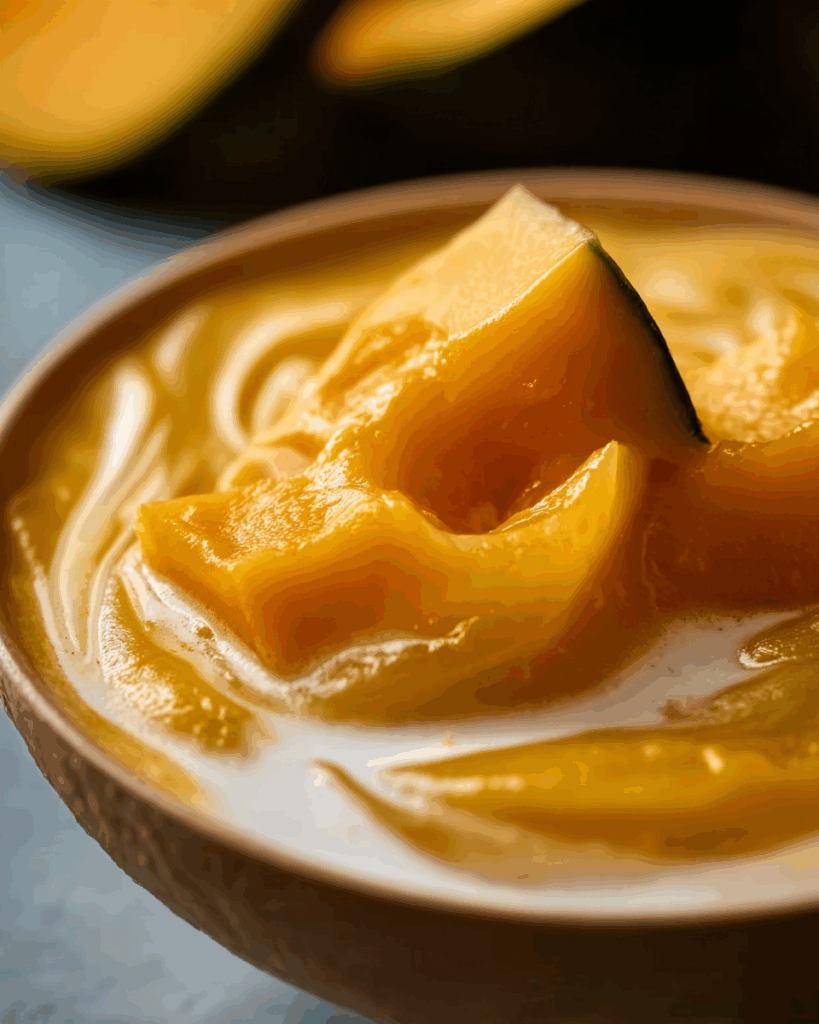
Pumpkin in coconut cream is not just a treat for your taste buds; it is also a nutrient-dense dish. Pumpkin is an excellent source of beta-carotene, a powerful antioxidant that your body converts into vitamin A, essential for maintaining healthy vision, immune function, and skin health. It also provides vitamin C, fiber, and potassium, which help support heart health and digestive wellness.
Coconut cream, the other star ingredient, is rich in healthy fats known as medium-chain triglycerides (MCTs). These fats are easily digested and converted into energy rather than being stored as fat. They also promote brain function and can increase satiety, helping you feel full longer. Additionally, coconut cream provides minerals like iron, magnesium, and phosphorus, which play important roles in bone health and energy production.
When combined, pumpkin and coconut cream create a dish that is not only satisfying but also nourishing. The natural sweetness of pumpkin means you can use less sugar, making it a healthier dessert or savory dish option compared to many other rich foods.
Why Pumpkin in Cream is a Healthier Dessert Option
Compared to traditional desserts made with dairy cream and refined sugar, pumpkin in coconut cream uses natural ingredients that are easier on your body. The coconut cream provides a creamy texture without the need for heavy cream, and the natural sugars in pumpkin allow for less added sweetener. Palm sugar, often used in the recipe, has a lower glycemic index than white sugar, meaning it causes a slower rise in blood sugar levels.
This dish is also gluten-free and can be made fully plant-based, which suits various dietary preferences. The healthy fats from coconut cream work well with the fiber in pumpkin to aid digestion and promote long-lasting energy. Eating pumpkin in coconut cream regularly in moderation can contribute to a balanced diet while still satisfying your craving for something sweet or savory.
Immune-Boosting Properties
Both pumpkin and coconut cream contain compounds that support the immune system. Beta-carotene in pumpkin helps fight oxidative stress and strengthens immune defenses, while the lauric acid found in coconut cream has antimicrobial properties that can help your body ward off infections.
During colder seasons, enjoying a warm bowl of pumpkin in coconut cream can be comforting while also supporting your body’s natural defenses. This makes it an ideal dish to include during fall and winter when colds and flu are more common.
Weight Management and Energy Benefits
Despite being rich and creamy, pumpkin in coconut cream can actually support weight management when enjoyed in reasonable portions. The MCTs in coconut cream can help boost metabolism and provide a quick source of energy, while the fiber in pumpkin helps you stay full. Together, they make this dish satisfying without being overly calorie-dense.
A Dish for Wellness and Pleasure
The beauty of pumpkin in coconut cream lies in its balance of indulgence and nutrition. You can enjoy it as a dessert without guilt or transform it into a savory meal that nourishes your body. Its ingredients work together to deliver vitamins, minerals, and healthy fats, making it much more than just a sweet treat.
Tips for Perfecting Pumpkin in Coconut Milk
Choosing the Right Pumpkin for Pumpkin in Milk
The first step to making the best pumpkin in coconut milk is selecting the right pumpkin. Thai kabocha squash is the most recommended variety because it has a naturally sweet flavor and a dense, creamy texture that holds up well during cooking. When you choose kabocha or any pumpkin, make sure it feels heavy for its size and has a deep, rich color. Freshness matters because it influences the final taste of your pumpkin in coconut milk. If kabocha is unavailable, sugar pumpkin or butternut squash can be great substitutes while still maintaining the delicious texture needed for this dish.
Preparing Pumpkin Correctly for Pumpkin in Coconut Milk
For a perfect texture, cut the pumpkin into evenly sized pieces. This ensures that all the chunks cook at the same rate. Some people prefer leaving the skin on because it softens during simmering and adds extra nutrients. Others remove it for a smoother texture. Both methods work well for pumpkin in coconut milk, so it comes down to personal preference. Always wash and dry the pumpkin thoroughly before cutting to keep the dish clean and fresh.
Using Quality Coconut Milk for Pumpkin in Coconut Milk
The coconut milk you use dramatically affects the outcome of your pumpkin in coconut milk. Choose a full-fat coconut milk to achieve the creamy consistency that this dessert is known for. Avoid diluted or low-fat versions, as they can make the dish watery. Shake the can or stir the coconut milk before using it because the fat sometimes separates from the liquid. For an even richer result, you can add a splash of coconut cream at the end of cooking. This extra layer of creaminess makes pumpkin in coconut milk exceptionally smooth and decadent.
Balancing Sweetness in Pumpkin in Coconut Milk
The sweetness of pumpkin in coconut milk should come from the natural sugars of the pumpkin combined with a small amount of palm sugar. Palm sugar adds a caramel-like depth that complements the pumpkin perfectly. Adjust the amount of palm sugar according to your taste and the natural sweetness of your pumpkin. If your pumpkin is already very sweet, you can use less sugar. This balance is key to making pumpkin in coconut milk enjoyable without being overly sugary.
Simmering Technique for Perfect Pumpkin in Coconut Milk
One of the most important tips is to simmer the dish gently. High heat can cause coconut milk to curdle or separate, which affects the texture. Keep the heat at medium-low and let the pumpkin cook slowly. Stir occasionally to prevent sticking, but avoid over-stirring, as this can break the pumpkin pieces. Pumpkin in coconut milk should have tender chunks that hold their shape, floating in a creamy coconut sauce.
Enhancing Flavor in Pumpkin in Coconut Milk
To make your pumpkin in coconut milk more fragrant, add pandan leaves during the simmering process. This traditional Thai touch gives the dish a wonderful aroma. For extra richness, drizzle a spoonful of coconut cream on top just before serving. You can also sprinkle roasted sesame seeds for added crunch. These small enhancements can elevate your pumpkin in coconut milk from simple to extraordinary.
Serving Ideas for Pumpkin in Coconut Milk
Pumpkin in coconut milk is typically served warm, which enhances its comforting quality. However, you can also chill it and serve it cold as a refreshing dessert in hot weather. The dish pairs beautifully with sticky rice for a traditional Thai treat or can be enjoyed on its own. For presentation, use a small bowl and add a swirl of coconut cream on top to make it visually appealing.
Making Pumpkin in Coconut Milk Ahead of Time
This dish can be prepared in advance and stored in the refrigerator for up to two days. When reheating, do so gently over low heat to prevent the coconut milk from separating. If it thickens too much, add a splash of water or extra coconut milk. The flavors of pumpkin in coconut milk often develop even more after sitting overnight, making it taste richer and more balanced.
Common Flavor Adjustments for Pumpkin in Coconut Milk
Some cooks like to add a pinch of salt to balance sweetness, while others may include a drop of vanilla extract for added depth. These small tweaks can make a big difference in how pumpkin in coconut milk tastes. If you’re experimenting, always adjust gradually to avoid overpowering the delicate balance of flavors.
Final Touches for Pumpkin in Coconut Milk
The final step to perfecting pumpkin in coconut milk is presentation. Serve it in a beautiful bowl, garnish with coconut cream, and maybe a few toasted sesame seeds. This not only makes the dish look inviting but also adds layers of flavor and texture. Every bite of pumpkin in coconut milk should be creamy, slightly sweet, and full of comforting flavors.
Common Mistakes to Avoid
Overcooking Pumpkin in Coconut Milk
One of the most common mistakes when making pumpkin in coconut milk is overcooking the pumpkin. Overcooked pumpkin becomes mushy and loses its structure, which can ruin the overall texture of pumpkin in coconut milk. To prevent this, monitor the cooking time closely and test the pumpkin with a fork. It should be tender but not falling apart. Proper timing ensures that every bite of pumpkin in coconut milk is creamy yet firm.
Using Low-Quality Coconut Milk in Pumpkin in Coconut Milk
The quality of coconut milk determines whether your pumpkin in coconut milk turns out rich and creamy or thin and bland. Low-quality coconut milk often contains added water and lacks the fat content needed for a silky texture. Always choose a full-fat, high-quality coconut milk to guarantee the best results for pumpkin in coconut milk. Avoid using light or watered-down versions, as they dilute the flavor and consistency of pumpkin in coconut milk.
Cooking Pumpkin in Coconut Milk on High Heat
Cooking pumpkin in coconut milk at high heat can cause the coconut milk to curdle. This results in a dish that looks grainy instead of smooth. To avoid this, simmer pumpkin in coconut milk gently over medium-low heat. Slow cooking preserves the natural sweetness of pumpkin in coconut milk and ensures the coconut base stays creamy.
Not Stirring Pumpkin in Coconut Milk Properly
While you should avoid over-stirring, not stirring at all can cause the pumpkin in coconut milk to stick to the bottom of the pot and burn. Stir occasionally to prevent scorching, making sure the pumpkin pieces stay coated in the sweet coconut mixture. A few gentle stirs during cooking keep the pumpkin in coconut milk perfect.
Adding Too Much Sugar to Pumpkin in Coconut Milk
Adding too much sugar can overpower the delicate balance of pumpkin in coconut milk. This dessert relies on the natural sweetness of the pumpkin, enhanced slightly by palm sugar. Excess sugar masks the pumpkin flavor and makes pumpkin in coconut milk overly sweet. Start with a smaller amount of sugar, taste, and adjust as needed.
Using the Wrong Pumpkin for Pumpkin in Coconut Milk
The type of pumpkin matters. Some varieties are watery and lack sweetness, which affects the quality of pumpkin in coconut milk. Kabocha squash is ideal because it’s dense and naturally sweet, making it perfect for pumpkin in coconut milk. Using the wrong pumpkin leads to a dish that is less flavorful and too watery.
Skipping the Salt in Pumpkin in Coconut Milk
A pinch of salt might seem minor, but skipping it results in a flat-tasting dessert. Salt enhances sweetness and balances the flavors in pumpkin in coconut milk. Without it, the dish can taste one-dimensional. Always include a small amount to bring out the full potential of pumpkin in coconut milk.
Using Cold Ingredients in Pumpkin in Coconut Milk
Adding cold coconut milk or cold pumpkin pieces directly to a hot pot can shock the mixture and cause separation. For a smooth result, bring ingredients to room temperature before cooking pumpkin in coconut milk. This small step makes a big difference in maintaining the creamy consistency of pumpkin in coconut milk.
Ignoring Garnish for Pumpkin in Coconut Milk
Presentation is part of the experience. Many skip garnishing, but a swirl of coconut cream or a sprinkle of sesame seeds elevates the look and flavor of pumpkin in coconut milk. The garnish adds texture and makes the dish more appealing, transforming a simple bowl of pumpkin in coconut milk into something special.
Not Allowing Pumpkin in Coconut Milk to Rest
Allowing the dish to rest briefly after cooking lets the flavors meld together. Serving pumpkin in coconut milk immediately is fine, but letting it sit for a few minutes makes it taste even better. Resting time helps the pumpkin absorb more coconut flavor, creating a richer and more cohesive dessert.
Storing Pumpkin in Coconut Milk Improperly
If you store pumpkin in coconut milk incorrectly, the texture may deteriorate. Always cool it completely before refrigerating, and use an airtight container. When reheating, do so over low heat to prevent curdling. Avoid microwaving on high, which can separate the coconut milk. Proper storage keeps leftover pumpkin in coconut milk tasting as good as when it was first made.
Serving Pumpkin in Coconut Milk at the Wrong Temperature
Pumpkin in coconut milk can be served warm or chilled, but serving it at an awkward temperature, like lukewarm, can make it less enjoyable. Warm pumpkin in coconut milk is comforting, while chilled pumpkin in coconut milk is refreshing. Choose the right temperature for the best experience.
Forgetting to Adjust Flavors in Pumpkin in Coconut Milk
Each pumpkin is different, so always taste your dish while cooking. Adjust sugar, salt, or coconut cream to ensure your pumpkin in coconut milk has the perfect balance of sweetness and creaminess. Failing to adjust flavors can result in a bland or overly sweet dessert.
Avoiding these mistakes guarantees that your pumpkin in coconut milk will always turn out creamy, flavorful, and satisfying. Every step, from ingredient choice to simmering and garnishing, influences the final result, so pay attention to the details to perfect your pumpkin in coconut milk.
Conclusion
This dish is more than just a simple recipe; it represents a blend of tradition, flavor, and comfort. Its origins trace back to Thai kitchens where it was prepared with care, using natural ingredients to create a dessert that satisfied both the heart and the appetite. Over time, it has evolved into many versions, from sweet to savory, adapting to different palates and cuisines around the world.
Throughout this article, we explored its history, ingredients, variations, health benefits, and tips for making it perfectly. Each element plays a vital role in achieving the balance that makes this dish so loved. Choosing the right squash, simmering slowly, and adjusting flavors to taste are small but significant steps in mastering it.
The versatility of this recipe allows you to enjoy it warm on a cold evening or chilled as a refreshing treat. It can also transition into soups, curries, and even pies, proving that it’s not limited to one form. Whether you stick to the classic version or try creative twists, it always delivers comfort in every bite.
Take the time to perfect your preparation, avoid common mistakes, and make adjustments based on your preferences. This will ensure that every serving captures the authentic flavor and texture that make it special. Once you have mastered it, you will find it becoming a staple in your kitchen, ready to be enjoyed at any time.
Frequently Asked Questions
Can I use coconut cream in pumpkin pie?
Yes, coconut cream can be used in pumpkin pie as a substitute for dairy cream. It adds richness and a subtle tropical flavor that pairs perfectly with pumpkin and traditional pie spices like cinnamon and nutmeg. Using coconut cream also makes the pie suitable for those who avoid dairy, while still maintaining a creamy filling.
Can you put pumpkin in curry?
Absolutely, pumpkin is a great ingredient for curry. Its natural sweetness offsets the heat and spices typically found in curries, creating a dish with layers of flavor. The soft texture of cooked pumpkin also blends well with creamy curry sauces, making it a popular choice in many Asian and Indian recipes.
Does coconut cream go well in pumpkin soup?
Coconut cream is an excellent addition to pumpkin soup because it makes the texture silkier and adds a mild sweetness that balances the earthy flavor of pumpkin. It also gives the soup a luxurious consistency without needing heavy cream. Many chefs use coconut cream to enhance both the flavor and appearance of pumpkin-based soups.
Do pumpkin and coconut milk go together?
Yes, these two ingredients complement each other beautifully. Pumpkin brings a natural sweetness and a velvety texture, while coconut milk adds a rich, creamy base that enhances the overall flavor. Together, they create a balanced dish that is both comforting and satisfying, whether served as a dessert or as part of a savory recipe.

Pumpkin in Coconut Milk
- Prep Time: 10 minutes
- Cook Time: 20 minutes
- Total Time: 30 minutes
- Yield: 4 servings 1x
- Category: Dessert
- Method: Simmering
- Cuisine: Thai
- Diet: Vegan
Description
A traditional Thai dessert featuring tender kabocha squash simmered in sweetened coconut milk, offering a creamy and slightly caramelized flavor.
Ingredients
- 1 cup coconut milk
- 1 cup water
- 1/4 cup palm sugar
- 2 cups kabocha squash, cut into bite-sized pieces
- 1/4 teaspoon salt
Instructions
- Wash the kabocha squash, cut it in half, and scoop out the seeds. Cut into bite-sized pieces, leaving the skin on or removing it as preferred.
- In a small saucepan, combine coconut milk and water over medium-high heat. Add palm sugar and salt, stirring to dissolve.
- Add the kabocha squash pieces to the saucepan and simmer in the sweetened coconut milk until the squash is fork tender.
- Scoop off any froth that accumulates on the surface while cooking.
- Serve the dessert warm in a small bowl. Optionally, swirl an extra spoonful of coconut milk on top before serving.
Notes
- You can adjust the sweetness by adding more or less palm sugar.
- Leaving the skin on the kabocha adds texture and nutrients.
- This dessert is best served warm but can also be enjoyed at room temperature.
Nutrition
- Serving Size: 1 bowl
- Calories: 180
- Sugar: 12g
- Sodium: 150mg
- Fat: 8g
- Saturated Fat: 6g
- Unsaturated Fat: 1g
- Trans Fat: 0g
- Carbohydrates: 24g
- Fiber: 3g
- Protein: 2g
- Cholesterol: 0mg
Keywords: Thai pumpkin dessert, kabocha squash in coconut milk, Thai dessert recipe, vegan Thai dessert

